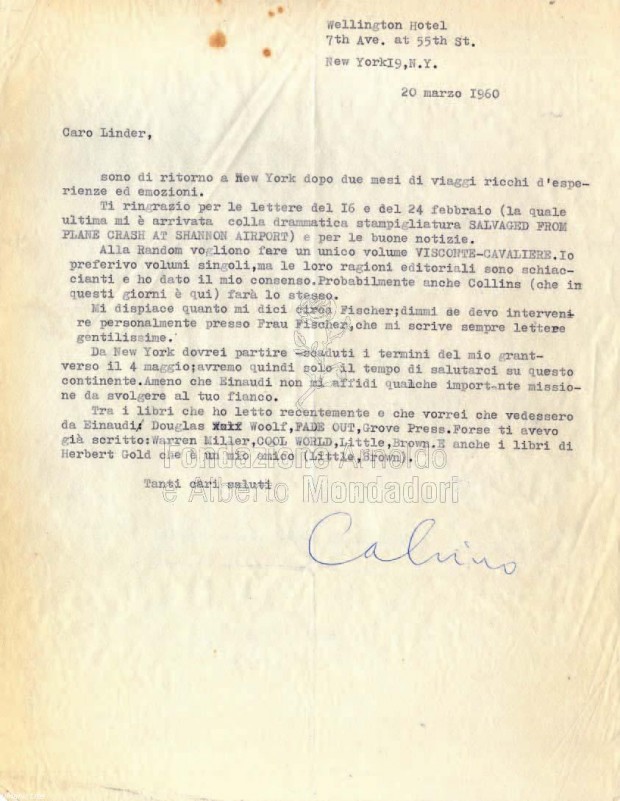An iconographic and text archive related to communication, technology and art.
Dear Pillo,
I have not written to you yet, I never write to anyone, New York has swallowed me up like a carnivorous plant swallowing a fly, I have been living a breathless life for fifty days now, here life consists of a series of appointments made a week or a fortnight in advance: lunch, cocktail party, dinner, evening party, these make up the various stages of the day which allow you constantly to meet new people, to make arrangements for other lunches, other dinners, other parties and so on ad infinitum. America (or rather New York, which is something quite separate) is not the land of the unforeseen, but it is the land of the richness of life, of the fullness of every hour in the day, the country which gives you the sense of carrying out a huge amount of activity, even though in fact you achieve very little, the country where solitude is impossible
☛ Italo Calvino: Letters, 1941-1985, trans. by Martin McLaughlin, with an introduction by Michael Wood, Princeton: Princeton University Press, 2013, p. 194. Read Michael Wood’s Introduction (PDF).
Compare with the impression New York made on Simone de Beauvoir while she was visiting from France ten years earlier: “But there’s something in the New York air…”
• • •

At the end of 1959, following an invitation from the Ford Foundation, Italo Calvino who had just turned 36 years old traveled for six months to the United States. The letters reproduced in Italo Calvino: Letters provide a supplement to the “American Diary 1959-1960” already published in Eremita a Parigi: pagine autobiografiche (translated in 2003 as Hermit in Paris: Autobiographical Writings).
Of the six months Calvino spent in the United States, four were spend ―rather frantically― in New York. In a letter addressed to Mateo Lettunich, Head of the Arts Division of the Institute of International Education, Calvino sketches the outlines of his travel schedule. It is clear from this planned schedule that New York was a priority destination:
Travels. It’s difficult for me to decide right now a schedule of travels. I believe that only when I’ll be in New York (where I plan to remain for some time) I’ll be able to make up my mind in a definitive way. The cities I would like to see besides New York are: San Francisco and Los Angeles; Chicago; and a town of the South (for instance: New Orleans). I could perhaps spend November and December in New York, travel in the States in January and February, and live through April and March in New York again (with short trips to Washington, Boston, etc.). (pp. 181-182).
New York can be intense. In the early days of experiencing the city, Calvino seems to have felt a bit overwhelmed:
In the early days I wanted to avoid living like a tourist; I wanted to be someone who lives in New York; after a while I noticed that I was not seeing New York at all but only moving through a sequence of business calls (as writer and as “editor”) (November 22, 1959, p. 188).
But the feeling must not have lasted for long and Calvino discovered he passionately love New York. On March 20, 1960 he wrote again about his newfound love:
Life in New York has started to become ferociously pleasant again. I must be daft, but I am more in love than ever with this horrendous city. New York is the only true love of my life.” (p. 562, note 126)
This love affair was not kept a secret: Calvino often spoke about it in various interviews and wrote about it in his “American Diary” (collected in Hermit in Paris). In an interview he did with Maria Corti in October 1985, he provided the following, poignant explanation:
The city which I have felt was my own city more than any other is New York. I once even wrote, imitating Stendhal, that I wanted ‘New Yorker’ to be engraved on my tombstone. That was in 1960. I have not changed my mind, even though I have lived most of the time since then in Paris, a city which I never leave except for brief periods and where perhaps, if I could choose, I will die. But every time I go to New York I find it more beautiful and closer to the shape of an ideal city. It may also be the fact that it is a geometric, crystalline city, without a past, without depth, apparently without secrets; therefore it is the city which intimidates me the least, the city which I can have the illusion of possessing in my mind, of being able to think about in its entirety all in the same instant. (Hermit in Paris: Autobiographical Writings, trans. by Jonathan Cape, New York: Vintage Books, p. 245)
To mark the publication of Italo Calvino: Letters, 1941-1985, The New Yorker ran a three-part series of excerpt from the book: see “The Letters of Italo Calvino” May 13, 2013, “The Letters of Italo Calvino, Day II” May 14, 2013 and “The Letters of Italo Calvino, Day III” May 15, 2013.
• • •
Previously:
- By Philippe Theophanidis
- on
- ― Published in Art, Literature
- Tagged: America, city, Italo Calvino, New York, United-States
